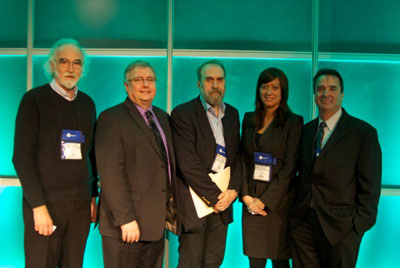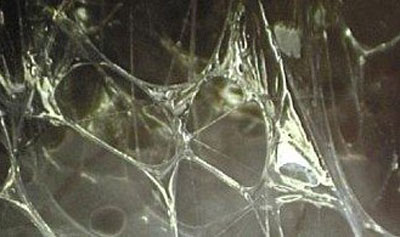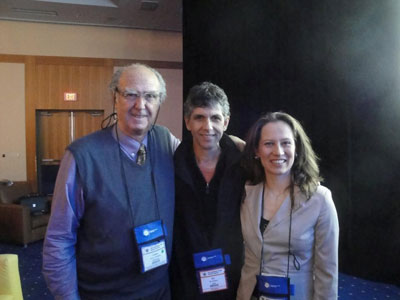
Features
Practice
Technique
Third International Fascia Research Congress
The 2012 International Fascia Research Congress – the third in this continuing series of conferences – turned out to be another stellar event right from the start.
July 9, 2012 By Cathy Ryan
The 2012 International Fascia Research Congress – the third in this continuing series of conferences – turned out to be another stellar event right from the start. The opening ceremonies began with an official welcome from delegates of the Squamish Nation, descendants of the Coast Salish Aboriginal Peoples. A huge “shout-out”to the MTABC (Host Sponsor), Ida P. Rolf Research Foundation (Conference Administrators), Planning Committee, Scientific Committee, Volunteers and Venue Staff for a job exceptionally well done.
 |
|
| A dynamic and fluid lineup: G. Pollack, M. Kuchera, R. Reed, L. Hodges and P. Standley. Image used with kind permission from Dave DeWitt.
|
Research presented at the FRCs has been painstakingly put together over many years by numerous individuals. There is no possible way to feature it all in a single article, so I’d like to preface the highlights with this statement; acknowledging the accomplishments and excellence of one in no way diminishes the importance and validity of another. The contribution of every individual involved is paramount to the far-reaching, collective value of the FRCs.
Multimicrovacuolar Sliding System, Viscosity and Hyaluronan (HA)
The current fascia-inclusive anatomical studies being conducted clearly confirm that we are in serious need of an Extreme Make-Over, Soft-tissue Edition! There are distinct histological regional, superficial and deep [fascia] layer differences that are extremely important but far too complex to cover thoroughly in this article. In a nutshell, although distinct, the layers (superficial and deep) are interconnected and are connected to other associated tissues (skin, muscle, tendon, nerves, etc.). This organization (i.e., in-series, myokinetic chain) supports functional and perceptive continuity along a limb, across the upper/lower and left/right parts of the body and supports that the connected tissues (muscle, tendon, nerve, fascia, etc.) function and dysfunction together.
One interesting feature of the deep fascial layer (DF) is the “sliding system” found between the various layers of the DF and between the DF and underlying muscle (epimysium).
In many areas of the body, denser layers of fascia are separated by sliding layers. The [thin] sliding layer comprises loose connective tissue (CT) and is rich in hyaluronan (HA). As such, this well-lubricated configuration augments sliding movements.
Along with its lubricating properties, HA also plays a significant role in tissue viscoelasticity.
Under “normal” circumstances HA is a lubricant; however, in soft-tissue [fascial] overuse situations, HA molecules become fragmented and accumulate, resulting in a more gel-like viscous medium. It is suggested that these [injury re-lated] HA aggregations are a potential source of impaired slide/glide, noci/proprioceptor agitation and soft-tissue/myofascial pain and dysfunction
It is also being proposed that the thickened areas of fascia seen in conjunction with soft-tissue injuries (e.g., chronic low back pain) may [in part] be due to an increase in HA in the sliding layer.
Heat (35-40 degrees Celsius, or 99-104 degrees Farenheit), alkalization and manual therapy are indicated measures to reduce trauma-related HA aggregation/viscosity.
Fibrosis and Timing
Simply put, fibrosis is shoddy myofascial architecture (excess collagen proliferation, aberrant fibre/bundle arrangement and reduced elastic-malleability) and arguably one of the most common issues we see come across our tabletops.
 |
|
| Fig. 1: The loose CT [microvacuolar bubble configuration] that allows for movement anywhere anatomical structures have to slide on one another. Image used with kind permission from Dr. J.C. Guimberteau and Endovivo Productions.
|
In the opening keynote address, Dr. Barbe pointedly affirmed that “timing of specific intervention is crucial. Repetitive motion-instigated changes in fascia is a two-stage process: inflammation and then fibrosis.” Although this is not necessarily new information for us MMTs, the better we understand the processes involved with Repetitive Motion Disorders (RMDs) the better we can educate our clients, our employers and organizations that provide work safety and injury prevention education. Additionally, this information can help educate those individuals or organizations that are in the position to determine the type/timing of treatment provided for those diagnosed with RMDs.
Fascia is more reactive to minimal/low-loading and therefore the intensity or amount of force required to cause injury is less than what we typically see with muscular injuries. With RMDs the most significant contributing factors are frequency of repetition (versus amount of load or resistance) and insufficient time to recuperate between agitations.
Dr. Barbe mentioned in her keynote: Once fibrosis is established, rest alone is not an effective treatment – no resolution is seen even after three months of rest. Even with appropriate treatment, inadequate rest can impede the recovery process. Also, age matters: as we age we tend to become more prone to developing RMDs, in part due to a higher concentration of circulating pro-inflammatory cytokines/chemokines, and perhaps age-related changes in our collagen architecture.
She continued, “From onset of insult to about week eight treatment ought to focus on mediating the inflammatory cascade. Inflammatory mediators do not necessarily [only] congregate locally and therefore systemic fallout ought to be considered. Anti-inflammatory measures (e.g., pharmaceutical or otherwise) show no benefit once there is a shift into the fibrosis stage; however, effective management during the inflammatory stage can help mediate myotendon/fascial and intra/extra neural fibrosis and the cascade of consequent sequelae.
“Observed local myelin degradation (seen in conjunction with RMS-related compression syndromes) is potentially reversible as long as proper and timely intervention is provided (before week 12). Techniques targeting [soft-tissue-mediated] nerve compression may derive the best, long-term and preventative, results if provided within this timeframe.”
Since it is rare that an individual seeks out treatment, of any kind, within the first eight weeks of beginning a new job or activity (i.e., the inflammatory stage), care providers are usually addressing fibrosis-related issues.
Movement, mobilizations and MMT are being shown to be useful in shifting tissue viscosity and “un-sticking” stuck sliding layers, thereby improving or restoring myofascial function and decreasing pain. Additionally, MMT and specific forms of exercise/movement therapy can assist with the restoration of elastic-malleability in fibrosed tissue and help re-establish correct tensional interplay between muscles and their fascia.
Scars and Adhesions
Current research suggests that post-surgical scars/adhesions can adversely impact the sliding mechanism, altering force transference and triggering mechanoreceptor signalling that is perceived as a pain message. When tissues are compressed, restricted or stuck – they don’t function normally and painful movement patterns typically ensue. With abdominal surgeries organ function can be compromised (e.g., impaired motility, obstructions).
Fifty-five to 100 per cent of surgical patients will experience post-surgical scar/adhesion complications that may not become evident until months or years later. Detection and diagnosis are hindered by lack of identifiable biomarkers, poor imaging methods or the onset of other health issues masking the underlying scar/adhesion sequelae. Re-operating to remove the offending scar tissue appears to be a case of fighting fire with fire – with questionable productive outcomes.
Recent studies suggest that MMT techniques aimed at ameliorating post-surgical scars/adhesions will derive the best [preventative] results if provided immediately following or within three to five days post surgery. It is important to take the necessary measures to ensure no risk of infection occurs.
Validation through Visualization
Using ultrasonography, Shah et al. were able to determine that Myofascial Trigger Points (MTrPs) can be distinguished from unaffected muscle (e.g., MTrPs are stiffer). Additionally, active MTrPs can be differentiated from latent MTrPs and unaffected muscle by an identifiable biochemical milieu (e.g., inflammatory mediators and pain/sensitization substances) and unique blood flow waveform characteristics.
During one of the breaks I thanked Dr. Shah for his and his colleagues’ work – he asked me what about their work was meaningful to me (as an RMT) – I responded, “validation.” Assessing for and treating MTrPs is nothing new to most MTs but now the commonly recognizable palpable and patient-subjective evaluation indicators can be supported by an additional objective, repeatable, reliable and inter-professionally recognized diagnostic test. Perhaps this will reduce those occasions when someone is told that there is nothing showing up diagnostically that could explain their pain and dysfunction; additionally, such confirmation can support their need for treatment.
Under the category of “BRAVO!” Dr. Guimberteau’s endoscopic series is an extraordinary in-vivo exploration of the human body and his film work is pure, elegant artistry. His presentations are always a big hit at the FRCs and once again he received the standing ovation he deserves! In his “Skin, Scars and Stiffness” presentation we observed the variances in non-injured tissue and tissue during and after scar formation. Notably, with irregular or abnormal healing (even though the surface tissue looks normal) below the surface undifferentiated tissue can be present for several months (e.g., thick/dense and devoid of microvacular bubbles [Fig. 1]). Additionally, the hypervasculization typically seen in the early stages of normal healing will persist far longer with abnormal or irregular healing. Interestingly, when reconstructive hardware is used (e.g., screws, plates, synthetic joint parts) normal scar formation does not occur.
Are you thinking, “All I want for Christmas is endoscopic views of post MMT treatment of scars/adhesions”? If so, check out the work of Bove and Chapelle; their recent paper in JBMT is a truly unique publication, demonstrating the effects of manual therapy on post-surgical intraperitoneal adhesions.
Water, Sunlight and Biological Processes
I have often said that “I am solar powered.” Thanks to Dr. Pollack, I now know how it is that I am solar powered.
 |
|
| A fascia-natingly dynamic trio: L. Chaitow, G. Hedley and C. Stecco. Image used with kind permission from Dr. Chaitow, www.leonchaitow.com.
|
Water near a hydrophilic surface (e.g., collagen or any tissue seeded with hydrophilic elements, such as group specific antigen genes [GAGs]) is different than bulk water in the human body. Near a hydrophilic surface [referred to as the exclusion zone (EZ)] water is in a gel-like state, solutes are excluded (e.g., bacteria) and EZ water is negatively charged. Adjacent bulk water is positively charged and thus fluid streaming [creating a current/energy source] can exist and be stored. The EZ water battery is charged [in part] by sunlight [infrared wave] and the stored energy can be converted into mechanical energy that can drive biological processes (e.g., push of red blood cells RBCs through circulation). And thus, I [we] are solar powered!
Significance of this work for MMTs includes its explanation of the detrimental impact of adhesions on our hydrophilic surfaces and how that not only affects movement/biomechanics but can also rob us of energy and render us more susceptible to infections, and its description of the implications associated with seasonal affective disorder. In addition to light, EZ water also responds (e.g., by increasing its expanse of negative charge) to thermal energy as well (e.g., touch and other heat sources). We often hear of the value of a positive outlook but when it comes to our EZs, a negative charge can exact a positive change!
Potential significant applications, beyond the human body, include utilizing EZ technology for water purification/desalinization and using it as a source of renewable energy. Gotta love that!
Fluid Dynamics: Plausible Mechanisms of Action
This is a brief paragraph, albeit a very important one. Work in this area is providing us with significant insight into some plausible mechanisms of action for MMT thereby affirming the credibility of MMT. In particular, how manually applied pressure/force (via the ingrin/mechanotransduction mechanism) can influence fluid composition and fluid movement (e.g., the sponge-like squeezing and refilling of fascia following stretch [Schleip et al.]). Applications include affecting circulatory/lymphatic flow, improving joint and other tissue lubrication, and attenuating the inflammatory and fibrotic processes.
An interesting note regarding mechanotransduction: mechanical strain is a faster activator of cellular response than agents (e.g., hormones or drugs). MMT causes no adverse side-effects, is non-invasive and is fast acting!
In closing, I humbly offer a few personal reflections. Mary Barbe is a fantastic lecturer, Leon Chaitow is as gracious as he is prolifically well-versed in all things manual therapy, Gil Hedley is fuzz-inatingly superb, Carla Stecco is well on her way to becoming one of the great anatomists of our time, and Susan Chapelle, RMT – excellent presentation and good-on-ya for representing! A heartfelt thank-you to Geoff Bove, PhD, DC (chair of the Scientific Committee), for his time and input; Dr. Bove, your dedication and passion is inspiring!
Acknowledgments
A very deserving acknowledgment goes out to the sponsors. Their generosity makes it possible.
The research presented encompassed several types and methods; more information can be found at http://www.fasciacongress.org/2012/. Abstracts can be found at http://fasciacongress.org/abstracts_2012.php.
Both the FRC3 proceedings book and DVD will be available for purchase at http://www.fasciacongress.org/2012/dvd-recordings-and-proceedings-books/.
| Practical Take-home Points Considerations for manually applied myofascial therapy:
i) slowly applied compression/stretch/ Considerations for manually applied lympathic work:
Notable Quotes from the Conference
|
Cathy Ryan, RMT, has maintained a diverse, treatment- oriented massage therapy practice and an extensive postgraduate training roster since 1990. Cathy is a longstanding member of provincial massage therapy associations and has served as a subject matter expert and examiner trainer at the CMTO’s provincial licensing examinations. Currently residing and working in beautiful B.C., Cathy maintains a private practice, teaches and writes massage therapy related material and is the managing editor for TouchU.ca; an online source providing accredited continuing education for touch professionals and students. Cathy can be reached at: cryanrmt@gmail.com or via www.touchu.ca.
Print this page